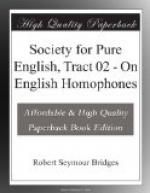Title: Society for Pure English, Tract 2, on English Homophones
Author: Robert Bridges
Release Date: December 1, 2004 [EBook #14227]
Language: English
Character set encoding: ASCII
*** Start of this project gutenberg EBOOK society for pure English, ***
Produced by David Starner, William Flis and the PG
Online Distributed
Proofreading Team.
Transcriber’s Note: Phonetic
characters are represented by the
following symbols:
[e] = upside-down “e” = schwa
[er] = italicized inverted “e”
= r-colored schwa
[a] = lower-case alpha
[o] = open “o” (appears as
upside-down “c”) = open-mid back
rounded vowel
[ng] = “eng” character = velar
nasal
[n.] = “n” with inferior dot
= devoiced “n”
[=u] = “u” with macron
[s] = “esh” (or long “s”)
character = voiceless palatoalveolar
(or postalveolar)
fricative
[z] = “ezh” (or “yogh”)
character = voiced palatoalveolar (or
postalveolar)
fricative
[ts] = t + “esh” = voiceless
palatoalveolar (or postalveolar)
affricate
[dz] = d + “ezh” = voiced
palatoalveolar (or postalveolar)
affricate
S.P.E.
TRACT NO. II
ON
ENGLISH HOMOPHONES
BY
ROBERT BRIDGES
MDCCCCXIX
* * * * *
ENGLISH HOMOPHONES
[Sidenote: Definition of homophone.]
When two or more words different in origin and signification are pronounced alike, whether they are alike or not in their spelling, they are said to be homophonous, or homophones of each other. Such words if spoken without context are of ambiguous signification. Homophone is strictly a relative term, but it is convenient to use it absolutely, and to call any word of this kind a homophone.[1]
[Footnote 1: Homophone is a Greek word meaning ‘same-sounding’, and before using the relative word in this double way I have preferred to make what may seem a needless explanation. It is convenient, for instance, to say that son and heir are both homophones, meaning that each belongs to that particular class of words which without context are of ambiguous signification: and it is convenient also to say that son and sun and heir and air are homophones without explaining that it is meant that they are mutually homophonous, which is evident. A physician congratulating a friend on the birth of his first-born might say, ’Now that you have a son and heir, see that he gets enough sun and air’.]




